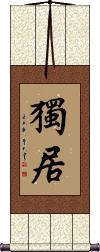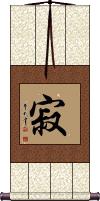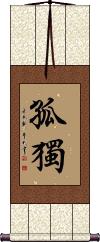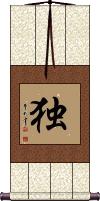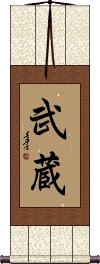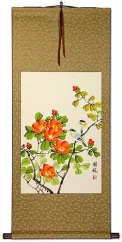Many custom options...
And formats...

Solitary in Chinese / Japanese...
Buy a Solitary calligraphy wall scroll here!
Personalize your custom “Solitary” project by clicking the button next to your favorite “Solitary” title below...
Alone / Solitary Existence
獨居 is a Chinese word that can be translated as to live alone, to live a solitary existence, solitude, solitary life, dwelling alone.
You might use a word like this regarding a hermit.
![]() In modern Japan, and Simplified Chinese, they use the version of the first character shown to the right. If you want this version please click on the character to the right instead of the button above.
In modern Japan, and Simplified Chinese, they use the version of the first character shown to the right. If you want this version please click on the character to the right instead of the button above.
Silent / Solitary
寂 means silent, solitary, quiet, calm, still, rest, or tranquil.
This also has a strong association with Buddhism where it can mean “entering into Nirvana.” In that context, this is sometimes used to refer to the passing of a Buddhist monk (he is silent, as he has entered Nirvana). For the living, this is about tranquility (especially of mind).
Some will also use this to mean “elegant simplicity.”
From Sanskrit, this can represent praśama, vivikta, śānti, or nibbāna (nirvāṇa).
Lonely Soul / Solitary
Lonely
孤獨 means lonely, solitude, loneliness, and lonesome.
In some contexts, it can mean reclusive, isolated, single, or solo.
孤獨 is a Japanese word but not a good selection for a wall scroll.
In Chinese, this will relay a rather sad feeling to anyone who reads this calligraphy on your wall.
![]() The version shown to the left is the Traditional Chinese and ancient Japanese version. In modern Japan and China they often use a different more simplified version of the second character (as shown to the right). If you want this Japanese/Simplified version, please click on the character shown to the right instead of the button above.
The version shown to the left is the Traditional Chinese and ancient Japanese version. In modern Japan and China they often use a different more simplified version of the second character (as shown to the right). If you want this Japanese/Simplified version, please click on the character shown to the right instead of the button above.
Hitori
This is the Japanese given name 独 which romanizes as Hitori or Doku.
Originally this was written as 獨 but was simplified/modernized in Japan at some point.
独 can also be an abbreviation for Germany.
The actual meaning is alone, independent, single, sole, only, or solitary.
This is also a Simplified Chinese character, but most Chinese calligraphers would prefer to write the Traditional Chinese of 獨 instead of 独.
Musashi
The most famous Samurai
Miyamoto Musashi is probably the most famous Samurai in all of Japanese history.
武蔵 is the short title for a man long in legend. While coming from a lower class, his new sword and fighting techniques put him on par with the best that feudal Japan had to offer. His long career started with his first duel at age 13!
He is credited with using two swords at once and never losing a single battle in his career. After becoming a Buddhist, and getting older, like many old warriors, he took up a peaceful and solitary life until his death around 1645 A.D.
Note: Technically, Musashi is his given name, and Miyamoto is his surname. However, it's suggested that he assumed both of these names and had a few other names in childhood, as well as being given a Buddhist name. It's hard to know what to call him, as with most Kanji, there are multiple pronunciations. The characters for Musashi can also be pronounced Takezō. But everyone in modern times seems to know him by the name Musashi.
This in-stock artwork might be what you are looking for, and ships right away...
These search terms might be related to Solitary:
A Journey of 1000 Miles Begins With a Single Step
Alone / a Lone Person
Lone Wolf
Lonely
Lonely Soul / Lost Soul
Lonely Soul / Solitary
Soldier / Private
The Single Life
There is One Single Thread Binding My Way Together
Not the results for solitary that you were looking for?
Below are some entries from our dictionary that may match your solitary search...
| Characters If shown, 2nd row is Simp. Chinese |
Pronunciation Romanization |
Simple Dictionary Definition |
寂 see styles |
jì ji4 chi yoshika よしか |
More info & calligraphy: Silent / Solitary(1) (entering into) nirvana; (suffix noun) (2) (used after a date to indicate the death of a monk at that time) died; (adj-t,adv-to) (3) (usu. せき) silent; tranquil; (female given name) Yoshika praśama; vivikta; śānti. Still, silent, quiet, solitary, calm, tranquil, nirvāṇa. |
聖 圣 see styles |
shèng sheng4 sheng mina みな |
More info & calligraphy: The Saint(1) highly virtuous monk; (2) (honorific or respectful language) monk; (3) Buddhist solitary; (4) (See 高野聖・1) Buddhist missionary; (5) saint (i.e. a virtuous person); (6) (archaism) (honorific or respectful language) emperor; (7) (in form 〜の聖) master; expert; (female given name) Mina ārya; sādhu; a sage; wise and good; upright, or correct in all his character; sacred, holy, saintly. |
孤獨 孤独 see styles |
gū dú gu1 du2 ku tu kodoku |
More info & calligraphy: Lonelyorphan |
独居 see styles |
dokkyo どっきょ |
More info & calligraphy: Alone / Solitary Existence |
獨居 独居 see styles |
dú jū du2 ju1 tu chü dokukyo |
More info & calligraphy: Alone / Solitary ExistenceDwelling alone, e.g. as a hermit. |
形單影隻 形单影只 see styles |
xíng dān yǐng zhī xing2 dan1 ying3 zhi1 hsing tan ying chih |
More info & calligraphy: Lonely Soul / Solitary |
孤 see styles |
gū gu1 ku sachihiko さちひこ |
lone; lonely (noun or adjectival noun) (1) being alone; solitude; loneliness; (2) (rare) (See 孤児・1) orphan; (personal name) Sachihiko Orphan, solitary. |
獨 独 see styles |
dú du2 tu doku |
alone; independent; single; sole; only Only, alone, solitary. |
一人 see styles |
yī rén yi1 ren2 i jen masato まさと |
(1) one person; (2) alone; unmarried; solitary; one person; (personal name) Masato a person |
伶俜 see styles |
líng pīng ling2 ping1 ling p`ing ling ping ryōbyō |
(literary) lonely; all alone; solitary wanders around |
孑然 see styles |
jié rán jie2 ran2 chieh jan ketsuzen けつぜん |
solitary; lonely; alone (adj-t,adv-to) isolated; alone; helpless |
孤城 see styles |
kojou / kojo こじょう |
solitary castle; isolated castle; (given name) Kojō |
孤孑 see styles |
gū jié gu1 jie2 ku chieh |
lonesome; solitary |
孤島 孤岛 see styles |
gū dǎo gu1 dao3 ku tao kotou / koto ことう |
isolated island solitary island; isolated island; (given name) Kotō |
孤帆 see styles |
kohan こはん |
solitary sailboat |
孤灯 see styles |
kotou / koto ことう |
solitary light |
孤絕 孤绝 see styles |
gū jué gu1 jue2 ku chüeh |
isolated; solitary |
孤老 see styles |
gū lǎo gu1 lao3 ku lao |
solitary old man or woman; regular patron (at brothels) |
孤膽 孤胆 see styles |
gū dǎn gu1 dan3 ku tan |
solitary hero; maverick |
孤舟 see styles |
koshuu / koshu こしゅう |
solitary boat; (given name) Koshuu |
孤雁 see styles |
kogan こがん |
solitary wild goose (i.e. separated from its flock, esp. flying); (given name) Kogan |
孤高 see styles |
gū gāo gu1 gao1 ku kao kokou / koko ここう |
arrogant (adj-no,n,adj-na) aloof; proudly independent; standing apart; solitary |
屏禁 see styles |
heikin / hekin へいきん |
{law} solitary confinement |
弧城 see styles |
kojou / kojo こじょう |
(irregular kanji usage) solitary castle; isolated castle |
挈挈 see styles |
qiè qiè qie4 qie4 ch`ieh ch`ieh chieh chieh |
alone; solitary |
支佛 see styles |
zhī fó zhi1 fo2 chih fo shibutsu |
辟支佛 A pratyekabuddha, who understands the twelve nidānas, or chain of causation, and so attains to complete wisdom. His stage of attainment is the 支佛地. |
牟尼 see styles |
móu ní mou2 ni2 mou ni muni むに |
(1) (honorific or respectful language) muni (Indian ascetic or sage); (2) Buddha (牟尼仙), 文尼; 茂泥; (馬曷摩尼) 摩尼 muni; mahāmuni; 月摩尼 vimuni. A sage, saint, ascetic, monk, especially Śākyamuni; interpreted as 寂 retired, secluded, silent, solitary, i. e. withdrawn from the world. See also 百八摩尼. |
独り see styles |
hitori ひとり |
(1) one person; (2) alone; unmarried; solitary |
独房 see styles |
dokubou / dokubo どくぼう |
(abbreviation) (See 独居監房) single-person cell; isolation cell; solitary cell; solitary confinement cell |
独行 see styles |
tokuyuki とくゆき |
(n,vs,vi) (1) going alone; travelling alone; solitary journey; (n,vs,vi) (2) self-reliance; acting independently; doing by oneself; (personal name) Tokuyuki |
Click here for more solitary results from our dictionary
The following table may be helpful for those studying Chinese or Japanese...
| Title | Characters | Romaji (Romanized Japanese) | Various forms of Romanized Chinese | |
| Alone Solitary Existence | 獨居 独居 | dokkyo / dokyo | dú jū / du2 ju1 / du ju / duju | tu chü / tuchü |
| Silent Solitary | 寂 | jaku | jì / ji4 / ji | chi |
| Lonely Soul Solitary | 形單影隻 形单影只 | xíng dān yǐng zhī xing2 dan1 ying3 zhi1 xing dan ying zhi xingdanyingzhi | hsing tan ying chih hsingtanyingchih |
|
| Lonely | 孤獨 孤独 | ko doku / kodoku | gū dú / gu1 du2 / gu du / gudu | ku tu / kutu |
| Hitori | 独 | hitori / doku | dú / du2 / du | tu |
| Musashi | 武蔵 | mu sashi / musashi | ||
| In some entries above you will see that characters have different versions above and below a line. In these cases, the characters above the line are Traditional Chinese, while the ones below are Simplified Chinese. | ||||
Successful Chinese Character and Japanese Kanji calligraphy searches within the last few hours...
